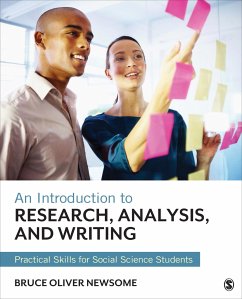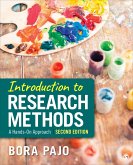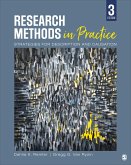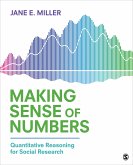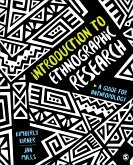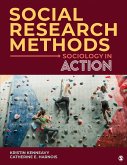Bruce Oliver Newsome
An Introduction to Research, Analysis, and Writing
Practical Skills for Social Science Students
Bruce Oliver Newsome
An Introduction to Research, Analysis, and Writing
Practical Skills for Social Science Students
- Broschiertes Buch
- Merkliste
- Auf die Merkliste
- Bewerten Bewerten
- Teilen
- Produkt teilen
- Produkterinnerung
- Produkterinnerung
Covering the full spectrum of skills needed, including planning, scoping, analysis, argumentation, theory building, modelling theories, methods, gathering data, presenting evidence, and writing, this book clearly helps students through each stage of doing a research project.
Andere Kunden interessierten sich auch für
![Introduction to Research Methods Introduction to Research Methods]() Bora PajoIntroduction to Research Methods153,99 €
Bora PajoIntroduction to Research Methods153,99 €![Introduction to Family Counseling Introduction to Family Counseling]() Judy F. EspositoIntroduction to Family Counseling177,99 €
Judy F. EspositoIntroduction to Family Counseling177,99 €![Research Methods in Practice Research Methods in Practice]() Dahlia K. K. Remler (Baruch College, CUNY, USA)Research Methods in Practice191,99 €
Dahlia K. K. Remler (Baruch College, CUNY, USA)Research Methods in Practice191,99 €![Making Sense of Numbers Making Sense of Numbers]() Jane E. E. Miller (USA Rutgers University)Making Sense of Numbers163,99 €
Jane E. E. Miller (USA Rutgers University)Making Sense of Numbers163,99 €![Introduction to Ethnographic Research Introduction to Ethnographic Research]() Kimberly Kirner (CSU Northridge)Introduction to Ethnographic Research121,99 €
Kimberly Kirner (CSU Northridge)Introduction to Ethnographic Research121,99 €![Social Research Methods Social Research Methods]() Social Research Methods191,99 €
Social Research Methods191,99 €![Researching City Life Researching City Life]() Researching City Life122,99 €
Researching City Life122,99 €-
-
-
Covering the full spectrum of skills needed, including planning, scoping, analysis, argumentation, theory building, modelling theories, methods, gathering data, presenting evidence, and writing, this book clearly helps students through each stage of doing a research project.
Hinweis: Dieser Artikel kann nur an eine deutsche Lieferadresse ausgeliefert werden.
Hinweis: Dieser Artikel kann nur an eine deutsche Lieferadresse ausgeliefert werden.
Produktdetails
- Produktdetails
- Verlag: SAGE Publications Inc
- Seitenzahl: 376
- Erscheinungstermin: 1. Juni 2015
- Englisch
- Abmessung: 230mm x 185mm x 10mm
- Gewicht: 682g
- ISBN-13: 9781483352558
- ISBN-10: 1483352552
- Artikelnr.: 41856231
- Herstellerkennzeichnung
- Libri GmbH
- Europaallee 1
- 36244 Bad Hersfeld
- gpsr@libri.de
- Verlag: SAGE Publications Inc
- Seitenzahl: 376
- Erscheinungstermin: 1. Juni 2015
- Englisch
- Abmessung: 230mm x 185mm x 10mm
- Gewicht: 682g
- ISBN-13: 9781483352558
- ISBN-10: 1483352552
- Artikelnr.: 41856231
- Herstellerkennzeichnung
- Libri GmbH
- Europaallee 1
- 36244 Bad Hersfeld
- gpsr@libri.de
Bruce Oliver Newsome, PhD, is a lecturer in the School of International & Area Studies at the University of California, Berkeley. Before teaching, he was a research policy scientist at the RAND Corporation in Santa Monica, California. He earned his undergraduate degree with honors in war studies from Kings College London, a master's degree in political science from the University of Pennsylvania, and PhD in international studies from the University of Reading.
1. The Way Ahead
Learning Objectives and Outcomes
Goals of This Book
Preview of the Rest of the Book
Chapter Summary
2. Research Process
Learning Objectives and Outcomes
Opening Vignette
What is Research?
What are the Objectives and Products of Research?
What are the Approaches to Research?
Project Life Cycle
Chapter Summary
Questions and Exercises
3. Research Ethics and Laws
Learning Objectives and Outcomes
Opening Vignette
What are Ethics?
Chapter Summary
Questions and Exercises
4. Scoping, Justifying, Designing, Planning
Learning Objectives and Outcomes
Opening Vignette
Scoping
The Value of Your Research
Feasibility
Developing a Research Question
Describing, Justifying, Planning, and Proposing the Research
Chapter Summary
Questions and Exercises
5. Reading and Reviewing
Learning Objectives and Outcomes
Opening Vignette
Sources
How to Read Efficiently
Content Analysis
Reviews
Chapter Summary
Questions and Exercises
6. Analysis
Learning Objectives and Outcomes
Opening Vignette
What is Analysis?
Why Do We Analyze?
How are We Told to Analyze?
How Should We Analyze?
Chapter Summary
Questions and Exercises
7. Arguing and Explaining
Learning Objectives and Outcomes
Opening Vignette
Definitions
Logical Arguments
True Arguments
Strong Versus Weak Arguments
Fallacious Arguments
Biases
Dialectic Arguments
Describing and Critiquing Arguments
Chapter Summary
Questions and Exercises
8. Theorizing and Modeling
Learning Objectives and Outcomes
Opening Vignette
Theories
Hypotheses
Models
Chapter Summary
Questions and Exercises
9. Methods
Learning Objectives and Outcomes
Opening Vignette
Methods and Methodologies
Historical Research
Case Study
Survey Research
Direct Observation in the Field
Experimental Research
Chapter Summary
Questions and Exercises
10. Evidence and Data
Learning Objectives and Outcomes
Opening Vignette
Observations and Data
Operationalization
Measurement
Classifying Data
Datasets
Uses of Data
Evidence
Causality and Correlation
Chapter Summary
Questions and Exercises
11. Writing
Learning Objectives and Outcomes
Opening Vignette
Planning the Writing of Your Whole Product
Style
Structure
Chapter Summary
Questions and Exercises
Learning Objectives and Outcomes
Goals of This Book
Preview of the Rest of the Book
Chapter Summary
2. Research Process
Learning Objectives and Outcomes
Opening Vignette
What is Research?
What are the Objectives and Products of Research?
What are the Approaches to Research?
Project Life Cycle
Chapter Summary
Questions and Exercises
3. Research Ethics and Laws
Learning Objectives and Outcomes
Opening Vignette
What are Ethics?
Chapter Summary
Questions and Exercises
4. Scoping, Justifying, Designing, Planning
Learning Objectives and Outcomes
Opening Vignette
Scoping
The Value of Your Research
Feasibility
Developing a Research Question
Describing, Justifying, Planning, and Proposing the Research
Chapter Summary
Questions and Exercises
5. Reading and Reviewing
Learning Objectives and Outcomes
Opening Vignette
Sources
How to Read Efficiently
Content Analysis
Reviews
Chapter Summary
Questions and Exercises
6. Analysis
Learning Objectives and Outcomes
Opening Vignette
What is Analysis?
Why Do We Analyze?
How are We Told to Analyze?
How Should We Analyze?
Chapter Summary
Questions and Exercises
7. Arguing and Explaining
Learning Objectives and Outcomes
Opening Vignette
Definitions
Logical Arguments
True Arguments
Strong Versus Weak Arguments
Fallacious Arguments
Biases
Dialectic Arguments
Describing and Critiquing Arguments
Chapter Summary
Questions and Exercises
8. Theorizing and Modeling
Learning Objectives and Outcomes
Opening Vignette
Theories
Hypotheses
Models
Chapter Summary
Questions and Exercises
9. Methods
Learning Objectives and Outcomes
Opening Vignette
Methods and Methodologies
Historical Research
Case Study
Survey Research
Direct Observation in the Field
Experimental Research
Chapter Summary
Questions and Exercises
10. Evidence and Data
Learning Objectives and Outcomes
Opening Vignette
Observations and Data
Operationalization
Measurement
Classifying Data
Datasets
Uses of Data
Evidence
Causality and Correlation
Chapter Summary
Questions and Exercises
11. Writing
Learning Objectives and Outcomes
Opening Vignette
Planning the Writing of Your Whole Product
Style
Structure
Chapter Summary
Questions and Exercises
1. The Way Ahead
Learning Objectives and Outcomes
Goals of This Book
Preview of the Rest of the Book
Chapter Summary
2. Research Process
Learning Objectives and Outcomes
Opening Vignette
What is Research?
What are the Objectives and Products of Research?
What are the Approaches to Research?
Project Life Cycle
Chapter Summary
Questions and Exercises
3. Research Ethics and Laws
Learning Objectives and Outcomes
Opening Vignette
What are Ethics?
Chapter Summary
Questions and Exercises
4. Scoping, Justifying, Designing, Planning
Learning Objectives and Outcomes
Opening Vignette
Scoping
The Value of Your Research
Feasibility
Developing a Research Question
Describing, Justifying, Planning, and Proposing the Research
Chapter Summary
Questions and Exercises
5. Reading and Reviewing
Learning Objectives and Outcomes
Opening Vignette
Sources
How to Read Efficiently
Content Analysis
Reviews
Chapter Summary
Questions and Exercises
6. Analysis
Learning Objectives and Outcomes
Opening Vignette
What is Analysis?
Why Do We Analyze?
How are We Told to Analyze?
How Should We Analyze?
Chapter Summary
Questions and Exercises
7. Arguing and Explaining
Learning Objectives and Outcomes
Opening Vignette
Definitions
Logical Arguments
True Arguments
Strong Versus Weak Arguments
Fallacious Arguments
Biases
Dialectic Arguments
Describing and Critiquing Arguments
Chapter Summary
Questions and Exercises
8. Theorizing and Modeling
Learning Objectives and Outcomes
Opening Vignette
Theories
Hypotheses
Models
Chapter Summary
Questions and Exercises
9. Methods
Learning Objectives and Outcomes
Opening Vignette
Methods and Methodologies
Historical Research
Case Study
Survey Research
Direct Observation in the Field
Experimental Research
Chapter Summary
Questions and Exercises
10. Evidence and Data
Learning Objectives and Outcomes
Opening Vignette
Observations and Data
Operationalization
Measurement
Classifying Data
Datasets
Uses of Data
Evidence
Causality and Correlation
Chapter Summary
Questions and Exercises
11. Writing
Learning Objectives and Outcomes
Opening Vignette
Planning the Writing of Your Whole Product
Style
Structure
Chapter Summary
Questions and Exercises
Learning Objectives and Outcomes
Goals of This Book
Preview of the Rest of the Book
Chapter Summary
2. Research Process
Learning Objectives and Outcomes
Opening Vignette
What is Research?
What are the Objectives and Products of Research?
What are the Approaches to Research?
Project Life Cycle
Chapter Summary
Questions and Exercises
3. Research Ethics and Laws
Learning Objectives and Outcomes
Opening Vignette
What are Ethics?
Chapter Summary
Questions and Exercises
4. Scoping, Justifying, Designing, Planning
Learning Objectives and Outcomes
Opening Vignette
Scoping
The Value of Your Research
Feasibility
Developing a Research Question
Describing, Justifying, Planning, and Proposing the Research
Chapter Summary
Questions and Exercises
5. Reading and Reviewing
Learning Objectives and Outcomes
Opening Vignette
Sources
How to Read Efficiently
Content Analysis
Reviews
Chapter Summary
Questions and Exercises
6. Analysis
Learning Objectives and Outcomes
Opening Vignette
What is Analysis?
Why Do We Analyze?
How are We Told to Analyze?
How Should We Analyze?
Chapter Summary
Questions and Exercises
7. Arguing and Explaining
Learning Objectives and Outcomes
Opening Vignette
Definitions
Logical Arguments
True Arguments
Strong Versus Weak Arguments
Fallacious Arguments
Biases
Dialectic Arguments
Describing and Critiquing Arguments
Chapter Summary
Questions and Exercises
8. Theorizing and Modeling
Learning Objectives and Outcomes
Opening Vignette
Theories
Hypotheses
Models
Chapter Summary
Questions and Exercises
9. Methods
Learning Objectives and Outcomes
Opening Vignette
Methods and Methodologies
Historical Research
Case Study
Survey Research
Direct Observation in the Field
Experimental Research
Chapter Summary
Questions and Exercises
10. Evidence and Data
Learning Objectives and Outcomes
Opening Vignette
Observations and Data
Operationalization
Measurement
Classifying Data
Datasets
Uses of Data
Evidence
Causality and Correlation
Chapter Summary
Questions and Exercises
11. Writing
Learning Objectives and Outcomes
Opening Vignette
Planning the Writing of Your Whole Product
Style
Structure
Chapter Summary
Questions and Exercises

